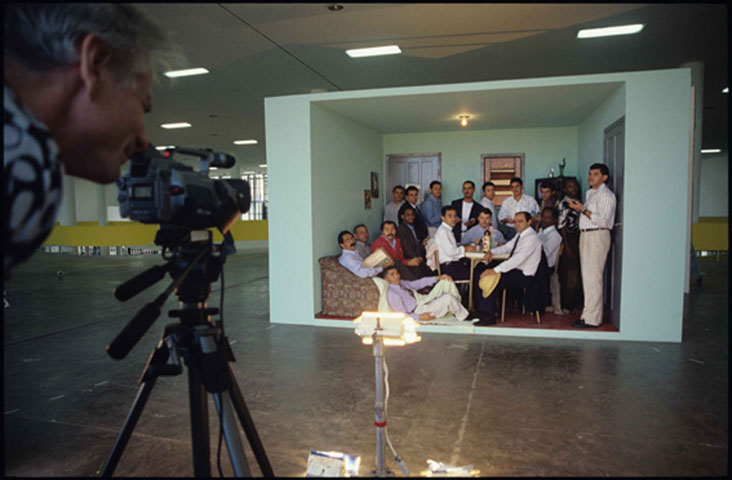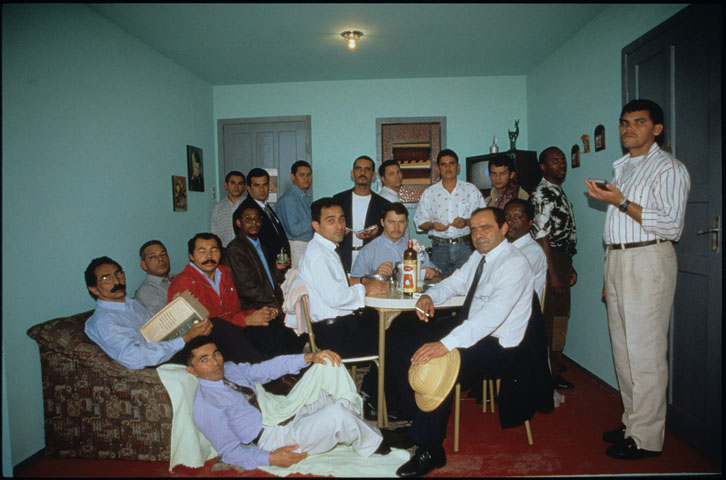







Mauricio Dias and Walter Riedweg stayed at the JCVA during October, 2013 for two and a half weeks. They arrived on the collaborative invitation of Eyal Danon, director and chief curator of the Israeli Center for Digital Art and Brazilian curator Benjamin Seroussi, with the aim of creating work that would be shown both at an exhibition at the upcoming Sau Paulo Biennale (September 2014, and in Israel.
They stayed in Jerusalem and Tel Aviv. In Jerusalem, they toured the Old City, studied the interfaces between the Jewish, Christian and Moslem quarters, and met and conversed at length with leading figures involved in interfaith relations, including Hana Bendcowsky, program director of the Jerusalem Center for Jewish- Christian Relations. They also met with Adolfo Roitman, curator of the Shrine of the Book at the Israel Museum. Matan Israeli of the Muslala group in the Musrara neighborhood -- on the seam between East Jerusalem and its west side -- took them for a tour of the group's rich art activism, where they were particularly impressed with both the aesthetics and the motivations at work. They got a glimpse of life between two distinct territories, of the conflicts and potential solutions, and said these tours raised many questions for them about the role of individuality and of the collective in these settings. Additionally, they visited Bethlehem and Ramallah, where they enjoyed touring and chance encounters with local residents.
Their consequent stay in effervescent, cosmopolitan Tel Aviv afforded them some time and more open space to digest the density and comparative isolation of Jerusalem, with its intensive multi-religious and multi-cultural politica/human fabric. In Tel Aviv they visited art exhibitions, toured on foot and on bike, and enjoyed the beachfront, which they compared to that of Rio de Janeiro, the ultimate democratic place where everyone can go to hang out and have fun.Os Raimundos, os Severinos e os Franciscos
Public art project and multimedia installation
Sao Paulo Biennale, 1998
At the climax of this work, we see twenty men packed into a small room raising their eyes from their various tasks and embarking on a long, collective stare at the camera. The men, doormen and janitors in Sao Paulo's large apartment buildings, are all migrant workers from northern Brazil; the piece raises the issue of their work conditions and status.
The artists invited thirty of these migrant workers to build a realistic model of a small backroom, the kind where these men spend much of their days. The piece, which was shown in the Sau Paulo biennale in an exhibition called Antrhopophagy, was filmed closed-frame so that viewers could not see that the space was only a model. The men were seen stepping into the room one after the other and simultaneously performing daily activities related to bodily maintenance and rest such as reading the paper, sitting, preparing food, etc.
The artists discovered that three names are particularly prevalent among the migrant doormen: Raimund, Severin and Francis. By pluralizing these three names in the title, the artists' point to the service men's de-individualized status. The backroom, the humble place where the men must attend to their own needs, is the antithesis of the shiny lobby at the entrance. This room is a metaphor for the workers' invisibility and diminished status. Through the simple, cheap, ascetic space, the indigestible relation between the wealthy and those who serve them is exposed.
On the "set" they built themselves, the service workers/actors stage their own lives. They display their daily activities which are normally behind the scenes; the theatricality of the piece results from the reversal wherein they bring what is normally backstage to the forefront, and make themselves the central actors of the drama. Through the joint choreography of their daily lives, each of the men receives a moment of recognition. In the climactic moment when they all face the camera as one, the men and the artists together have fashioned a compelling call. The men's collective gaze empowers their stance; for a moment, the potential force they embody is revealed in the very environment that keeps them isolated and transparent.
Moving Truck
Brussels, New York City, Rio de Janeiro, Copenhagen, 2009
Moving truck is an ongoing art project composed of a series of video screenings on the back of a truck stationed or driving in the vicinity of the duo's exhibitions in various cities around the world. In Brussels, in 2009, the truck was part of the 9th Kunstenfestival des Arts exhibition; the work projected on it was Throw, from 2004. That work shows residents of Helsinki, Finland, throwing objects in slow motion towards a camera in a glass-proof case, as well as still photographs documenting past demonstrations in the city. When the work was shown, the artists filmed the responses and curiosity of passersby. That second layer of documentation was edited and later shown on the back of a truck in New York's Fifth Avenue, during the duo's opening at the American Society Art Galley. In this case, too, passersby were documented with video, and the documentation was then shown on the back of a truck parked at the entry to the Filomena Soares Gallery in Lisbon, later that same year. This last documentation was projected on the back of a truck that was traveling in Mexico City during the artists' show there at the Muac.
The artists call what takes place around the truck and the screenings Street Action. In each case, the mobile screening acts as a basis for interaction with viewers in the public space. Documenting these interactions creates an accumulation of layers that address geography, globalization, motion and time, as well as the very potential of art actions in the public domain. The recurring documentation of the course of the work, the moving truck, the screening and the public of curious onlookers, repeatedly expose the work's inverted internal mechanism. The documentation of the action guarantees the continuation of the piece next time, but each chapter only points to its existence as a link in an infinite self-enclosed series, one whose past is dissolving while its future is being prepared.
Along with the self-enclosed nature of the piece, its extroverted aspect involves and activates passersby and turns them into spectators and even active participants. The passersby are engaged by the large screening which documents past passersby who were watching Moving Truck. The work propels these passersby to watch and wonder at other people's projected curiosity towards the same truck in an earlier stop of its journey. In this way the audience, partly past and screened, partly real and real-time, is reinforced by its mirrored twin, and thus reinforced creates an additional happening in the public domain.